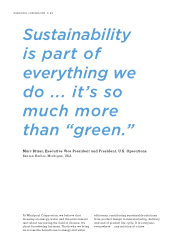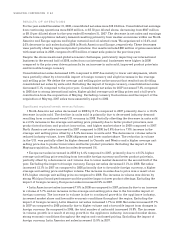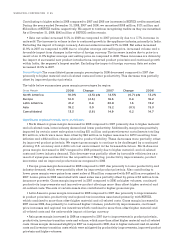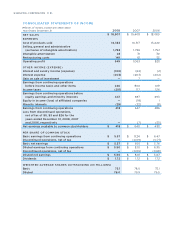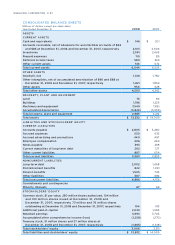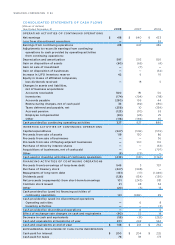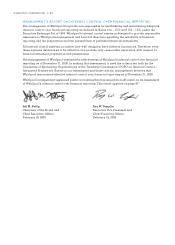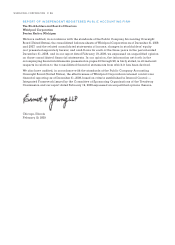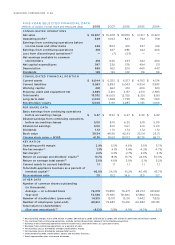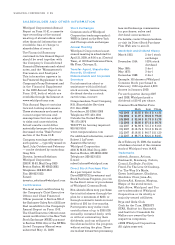Whirlpool 2008 Annual Report Download - page 91
Download and view the complete annual report
Please find page 91 of the 2008 Whirlpool annual report below. You can navigate through the pages in the report by either clicking on the pages listed below, or by using the keyword search tool below to find specific information within the annual report.
support our global products, brands and customers. We intend to make additional investments to
improve our competitiveness in fiscal 2009. Capital spending is expected to be between $450 and
$500 million in 2009 in support of our investment in innovative product technologies and our global
operating platform initiatives.
Cash provided by financing
activities from continuing operations was an inflow of $141 million in the year ended December 31, 2008
compared to an outflow of $696 million for the year ended December 31, 2007. The current year reflects
proceeds received related to the issuance of $500 million of 5.5% notes due March 1, 2013 and the repayment
of $125 million of 9.1% debentures. Net proceeds of short-term borrowings were $101 million for the year
ended December 31, 2008 compared to net repayments of $243 million in the prior year. During 2008,
we repurchased stock totaling $247 million, paid dividends to common stockholders totaling $128 million
and received proceeds from the issuance of common stock related to option exercises of $21 million.
Cash used in financing activities from continuing operations was an outflow of $696 million in the year
ended December 31, 2007 compared to an inflow of $29 million for the year ended December 31, 2006.
Net repayments of short-term borrowings were $243 million for the year ended December 31, 2007
compared to borrowings of $381 million in 2006. Cash flows from financing activities in 2006 also
reflected short-term debt issued to pay our maturing $300 million Eurobond principal and proceeds of
long-term debt which replaced commercial paper borrowings initially issued to finance the acquisition
of Maytag. Repayments of long-term debt reflect the maturity of Whirlpool and Maytag debt.
During the year ended December 31, 2007 we also repurchased stock totaling $368 million, paid
dividends to common stockholders totaling $134 million and received proceeds from the issuance of
common stock related to option exercises of $68 million.
We have in place an Enterprise Risk Management process that involves systematic risk identification
and mitigation covering the categories of Enterprise, Strategic, Financial, Operation and Compliance
and Reporting risk. The Enterprise Risk Management process receives Board of Directors and Management
oversight, drives risk mitigation decision-making and is fully integrated into our internal audit
planning and execution cycle.
We are exposed to market risk from changes in foreign currency exchange rates, domestic and foreign
interest rates, and commodity prices, which can affect our operating results and overall financial
condition. We manage exposure to these risks through our operating and financing activities and,
when deemed appropriate, through the use of derivative financial instruments. Derivative financial
instruments are viewed as risk management tools and are not used for speculation or for trading
purposes. Derivative financial instruments are contracted with a diversified group of investment grade
counterparties to reduce exposure to nonperformance on such instruments.
We use foreign currency forward contracts, currency options and currency swaps to hedge the price
risk associated with firmly committed and forecasted cross-border payments and receipts related to
ongoing business and operational financing activities. Foreign currency contracts are sensitive to
changes in foreign currency exchange rates. At December 31, 2008, a 10% unfavorable exchange rate
movement in each currency in our portfolio of foreign currency contracts would have resulted in an
incremental unrealized loss of approximately $25 million, while a 10% favorable shift would have
resulted in an incremental unrealized gain of approximately $29 million. Consistent with the use of
these contracts to neutralize the effect of exchange rate fluctuations, such unrealized losses or gains
would be offset by corresponding gains or losses, respectively, in the re-measurement of the
underlying exposures.
We enter into commodity swap contracts to hedge the price risk associated with firmly committed
and forecasted commodities purchases that are not fixed directly through supply contracts. As of
December 31, 2008, a 10% favorable or unfavorable shift in commodity prices would have resulted in
an incremental $15 million gain or a $24 million loss related to these contracts.
We utilize interest rate swaps to hedge our interest rate risk. As of December 31, 2008, a 10% shift in
interest rates would have resulted in an incremental $1 million gain or loss related to these contracts.



